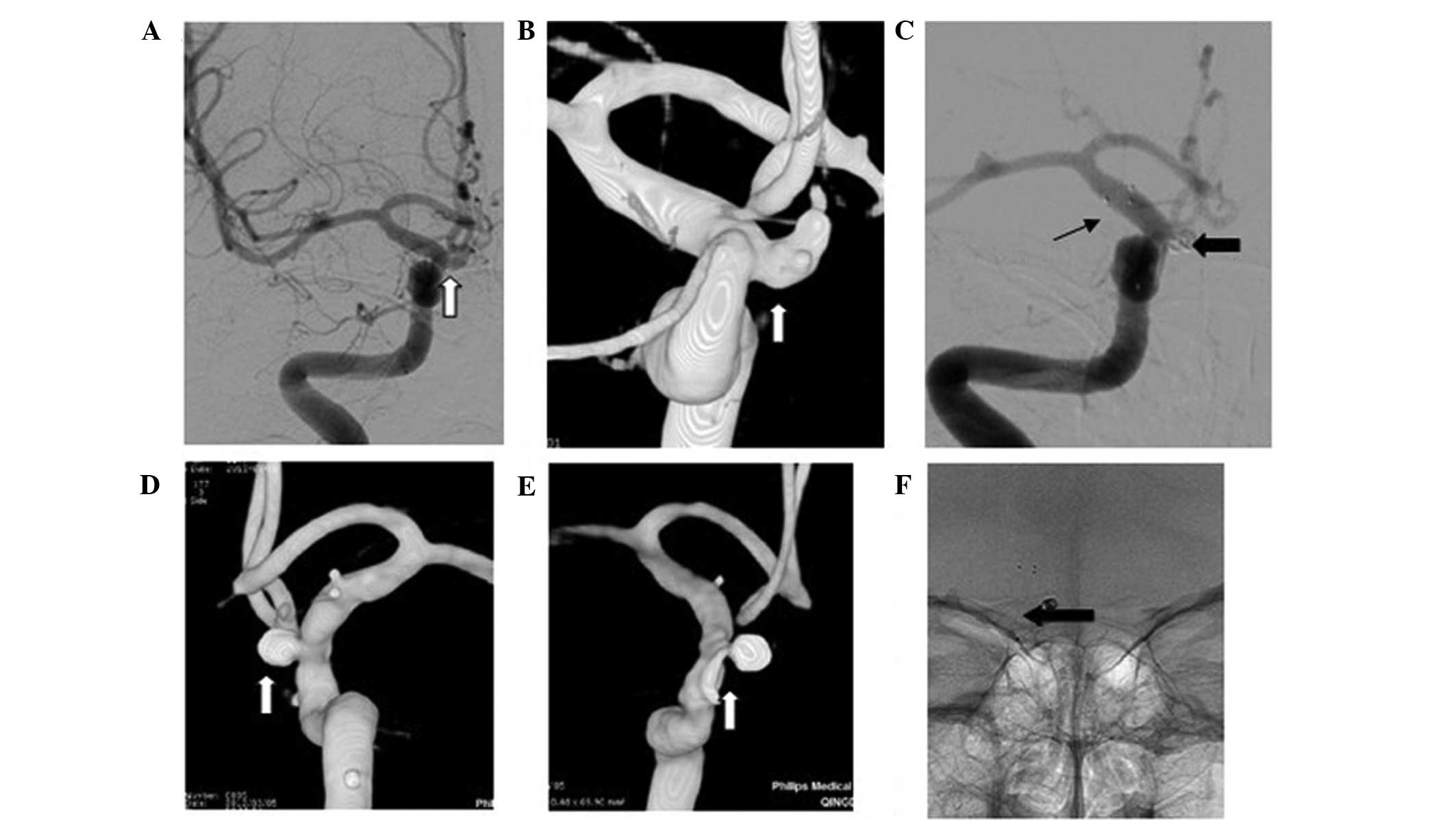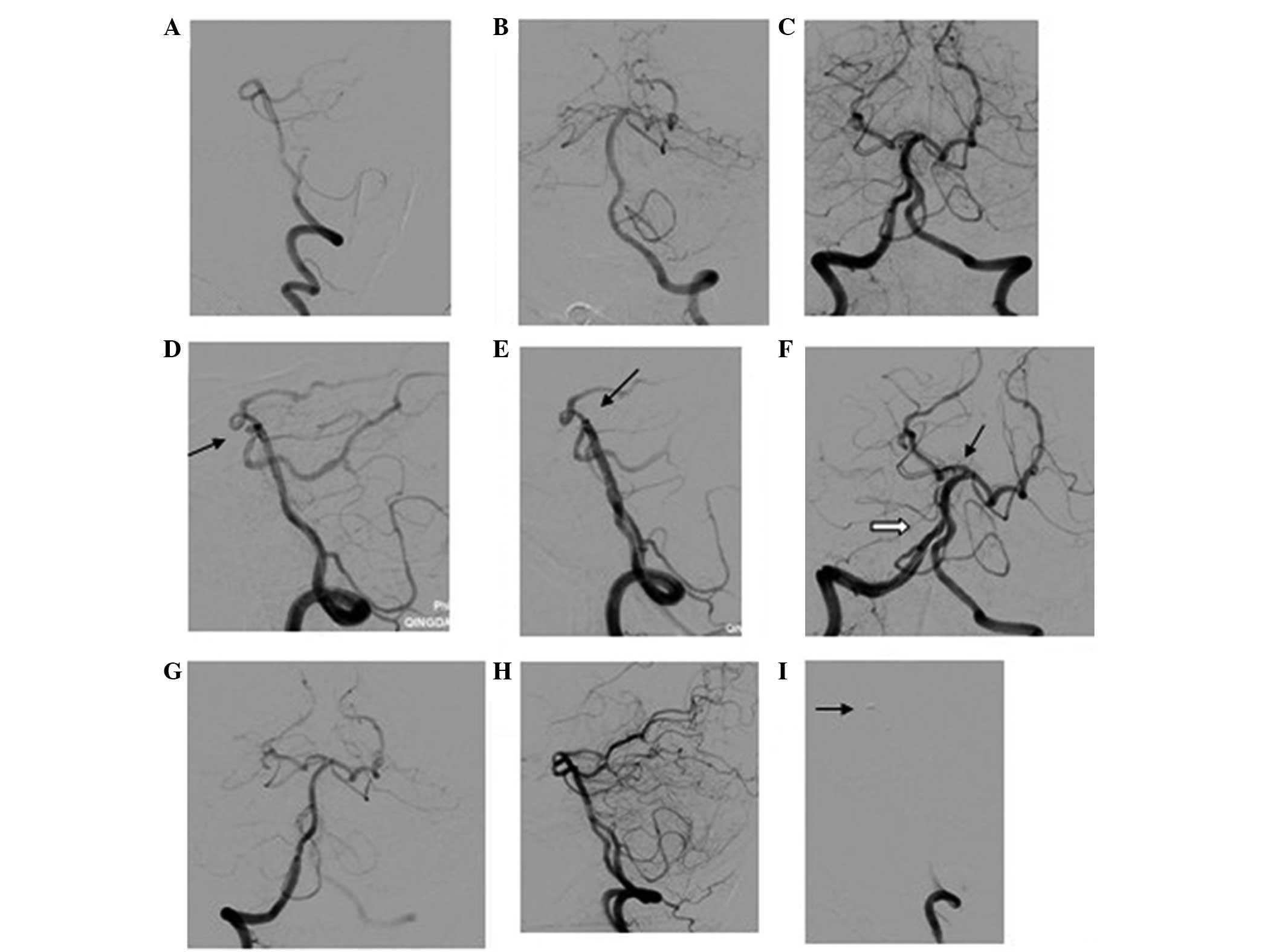|
1
|
Zhang HQ: Is it necessary to treat the
mini unruptured intracranial aneurysms? Chin J Cerebrovasc Dis.
10:1–3. 2013.
|
|
2
|
van Rooij WJ, Sprengers ME, de Gast AN,
Peluso JP and Sluzewski M: 3D rotational angiography: The new gold
standard in the detection of additional intracranial aneurysms.
AJNR Am J Neuroradiol. 29:976–979. 2008. View Article : Google Scholar : PubMed/NCBI
|
|
3
|
Gross BA and Frerichs KU: Stent usage in
the treatment of intracranial aneurysms: Past, present and future.
J Neurol Neurosurg Psychiatry. 84:244–253. 2013. View Article : Google Scholar : PubMed/NCBI
|
|
4
|
Almekhlafi MA, Hockley A, Wong JH and
Goyal M: Temporary Solitaire stent neck remodeling in the coiling
of ruptured aneurysms. J Neurointerv Surg. 5(Suppl 3): iii76–iii78.
2013.PubMed/NCBI
|
|
5
|
Gory B, Klisch J, Bonafé A, et al:
Solitaire AB stent-assisted coiling of wide-necked intracranial
aneurysms: Short-term results from a prospective, consecutive,
European multicentric study. Neuroradiology. 55:1373–1378. 2013.
View Article : Google Scholar : PubMed/NCBI
|
|
6
|
Clajus C, Sychra V, Strasilla C and Klisch
J: Stent-assisted coil embolization of intracranial aneurysms using
the Solitaire™ AB Neurovascular Remodeling Device: Initial and
midterm follow-up results. Neuroradiology. 55:629–638. 2013.
View Article : Google Scholar : PubMed/NCBI
|
|
7
|
Zhao KJ, Zhang YW, Xu Y, et al:
Reconstruction of saccular and dissected intracranial aneurysms
using Solitaire™ AB stents. PLoS One. 8:e572532013. View Article : Google Scholar : PubMed/NCBI
|
|
8
|
Roy D, Milot G and Raymond J: Endovascular
treatment of unruptured aneurysms. Stroke. 32:1998–2004. 2001.
View Article : Google Scholar : PubMed/NCBI
|
|
9
|
Bonita R and Beaglehole R: Recovery of
motor function after stroke. Stroke. 19:1497–1500. 1988. View Article : Google Scholar : PubMed/NCBI
|
|
10
|
Hong B, Yang PF, Zhao R, et al:
Endovascular treatment of ruptured tiny intracranial aneurysms. J
Clin Neurosci. 18:655–660. 2011. View Article : Google Scholar : PubMed/NCBI
|
|
11
|
Gupta V, Chugh M, Jha AN, Walia BS and
Vaishya S: Coil embolization of very small (2 mm or smaller) berry
aneurysms: Feasibility and technical issues. AJNR Am J Neuroradiol.
30:308–314. 2009. View Article : Google Scholar : PubMed/NCBI
|
|
12
|
Brinjikji W, Lanzino G, Cloft HJ,
Rabinstein A and Kallmes DF: Endovascular treatment of very small
(3 mm or smaller) intracranial aneurysms: Report of a consecutive
series and a meta-analysis. Stroke. 41:116–121. 2010. View Article : Google Scholar : PubMed/NCBI
|
|
13
|
Lu J, Liu JC, Wang LJ, Qi P and Wang DM:
Tiny intracranial aneurysms: Endovascular treatment by coil
embolisation or sole stent deployment. Eur J Radiol. 81:1276–1281.
2012. View Article : Google Scholar : PubMed/NCBI
|
|
14
|
Fang C, Li MH, Zhu YQ, et al: The
effectiveness and feasibility of endovascular coil embolization for
very small cerebral aneurysms: mid- and long-term follow-up. Ann
Vasc Surg. 24:400–407. 2010. View Article : Google Scholar : PubMed/NCBI
|
|
15
|
Im SH, Han MH, Kwon OK, et al:
Endovascular coil embolization of 435 small asymptomatic unruptured
intracranial aneurysms: Procedural morbidity and patient outcome.
AJNR Am J Neuroradiol. 30:79–84. 2009. View Article : Google Scholar : PubMed/NCBI
|
|
16
|
Zhou C, Hong QH, Zhao R, Xu Y, Hong B and
Zhao WY: Stent-assisted coil embolization of ruptured anterior
communicating artery tiny aneurysms. Chin J Cerebrovasc Dis.
10:9–12. 2013.
|
|
17
|
Martínez-Galdámez M, Saura P, Saura J,
Martínez A, De Campos JM and Pérez A: Y-stent-assisted coil
embolization of anterior circulation aneurysms using two Solitaire
AB devices: A single center experience. Interv Neuroradiol.
18:158–163. 2012.PubMed/NCBI
|
|
18
|
Sychra V, Klisch J, Werner M, et al:
Waffle-cone technique with Solitaire™ AB remodeling device:
Endovascular treatment of highly selected complex cerebral
aneurysms. Neuroradiology. 53:961–972. 2011. View Article : Google Scholar : PubMed/NCBI
|
|
19
|
Klisch J, Clajus C, Sychra V, et al: Coil
embolization of anterior circulation aneurysms supported by the
Solitaire AB Neurovascular Remodeling Device. Neuroradiology.
52:349–359. 2010. View Article : Google Scholar : PubMed/NCBI
|
















